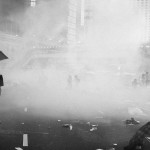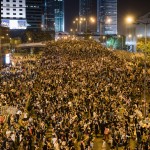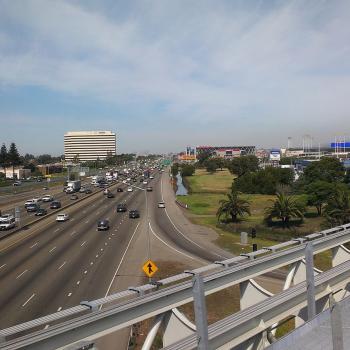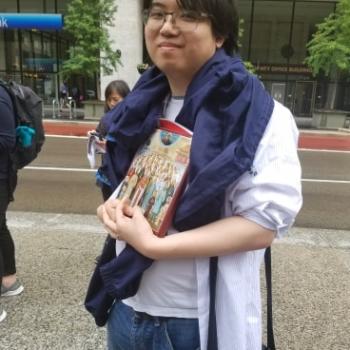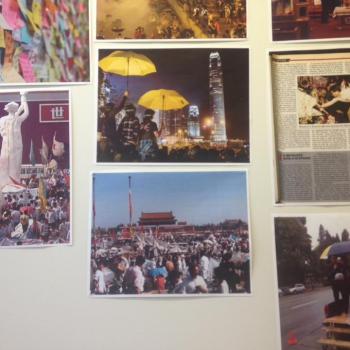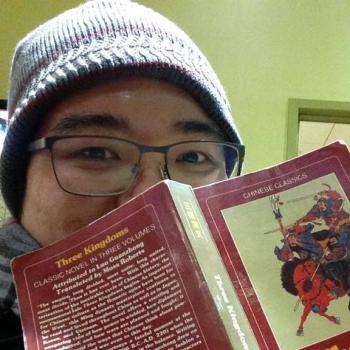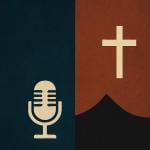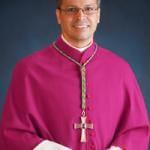![Umbrella Man in the Umbrella Movement - by Pasu Au Yeung (2014_Hong_Kong_Umbrella_Revolution_as_Police_Attacked_Peaceful_Demonstrators_with_Tear_Gas_) [CC-BY-SA 2.0 (https://creativecommons.org/licenses/by-sa/2.0/deed.en)], via Wikimedia Commons](https://wp-media.patheos.com/blogs/sites/721/2014/09/2014_Hong_Kong_Umbrella_Revolution_as_Police_Attacked_Peaceful_Demonstrators_with_Tear_Gas_%E9%A6%99%E6%B8%AF%E6%B8%A3%E6%89%93%E9%9D%A9%E5%91%BD%E4%B9%8B%E5%92%8C%E5%B9%B3%E6%8A%97%E8%AD%B0%E7%9A%84%E9%A6%99%E6%B8%AF%E4%BA%BA%E6%B0%91%E4%BB%A5%E9%9B%A8%E5%82%98%E5%B0%8D%E6%8A%97%E7%99%BC%E7%A4%BE%E5%82%AC%E6%B7%9A%E5%BD%88%E7%9A%84%E6%B8%AF%E8%AD%A6-1024x576.jpg)
This puts enormous clarity as to what’s going on in Hong Kong. While there have been reports that there is dissension among the leadership, leaders as diverse as Benny Tai, Joshua Wong, Joseph Cardinal Zen, and others have each gone on the record saying that what has happened in Hong Kong has surpassed their wildest imaginations. Speculations abounded in recent months that these movements would not garner enough popular support to be viable. It seems that the tide has changed dramatically.
It’s important to understand why. After all, for a Special Administrative Region in which people have claimed over and over again that there is no democratic tradition, it seems strangely odd that people know what they’re doing. Moreover, despite the unpredictability expressed by various leaders of the various factions that have come together in this public protest, it feels like all of this has happened before.
It has.
What I want to suggest is that Hong Kong has long had its own democratic tradition. What I also want to dismiss is that the British gave it to them. What I also want to explore is that this democratic tradition has in turn produced opponents of its own in the sort of skepticism about political agency by which many Hongkongers are said to be marked. I know all of this because it was a big part of my dissertation research, which you can read here: the chapters are generally arranged by my research on Cantonese Protestants in the order of San Francisco Bay Area first, Vancouver second, and Hong Kong third, so you can read the last third of chapters 4, 5, 6, and 7 if you want the goods on Hong Kong democratic movements.
Let’s start with the skepticism. If we want to understand why Hong Kong people have a bit of a phobia for disorder, tear gas, rumours of assassinations, and protest occupations, we have to look to the riots that happened in Hong Kong in 1966 and 1967. In 1966, two protesters occupied the Star Ferry to demonstrate against a hike in ferry prices. When they were arrested, the situation escalated to the point that the British military was called in to threaten that agitators would be shot. The memory of 1967 then gets wrapped up with what happened here: then, students associated with the Red Guard in Cultural Revolution China tried to get Hong Kong on board with Mao’s agenda up north. They weren’t very successful: after all, they marched in the streets with Mao’s little red book, planted bombs in the street, and murdered a radio host, among other things. This memory became implanted in the Hong Kong imagination about protest, and while a lot of the people at the time won’t tell you that this was the reason they moved away from Hong Kong, whenever I dig around in an interview with somebody who left Hong Kong to go to school in North America after 1967, the riots always most certainly come up. I also find that those people generally don’t like public protests very much.
I know that 1967 became implanted in the Hong Kong imagination because of what happened in 1977. That was around the time that Hong Kong established an Independent Commission Against Corruption (ICAC). Because it was so new, some younger people were fairly zealous about cracking down on corruption, and at the Precious Blood Golden Jubilee Secondary School, three young teachers who discovered that their principal, Sr. Beatrice Leung, had some financial irregularities in her transactions. They reported her to the ICAC. The ICAC didn’t find that her actions were criminal; nevertheless, the school got rid of her.
But here’s where 1967 comes into 1977. The school revised those teachers’ contracts and lowered their salaries to punish them because they thought that they were the same kinds of radical leftists who had planted bombs, touted Mao’s little red book, and murdered the radio host. When the students at this all girls’ school found out about that, they occupied the playground. That was quickly quelled.
At that point, the new archbishop of Hong Kong appointed a new headmistress whose description has always sounded to me like the Chinese version of Dolores Umbridge from Harry Potter and the Order of the Phoenix. Going off the information she had on the idea that protesting teachers and students are radical leftists, she imposed a rule that students could not assemble together. When she suspended one group of students she thought was planning revolutionary activities, the teachers and the students began to publicly show their unrest, which caught the attention of emerging democracy activist Szeto Wah. In May 1978, Wah and the Golden Jubilee teachers and students physically occupied the compound in front of the archbishop’s residents for one month, demanding that the new headmistress be sacked and the suspended students reinstated.
That’s when they discovered that the colonial government and the Catholic Church were in cahoots. Instead of listening to their demands, the colonial government went behind their backs and sealed the school, in effect firing all the teachers and expelling all the students for the Church. That’s when a protest movement began to swell; some have told me some 10,000 people gathered in support of the students. A new evangelical youth ministry organization, Breakthrough Youth Ministries, issued a combined statement from secular and church ministries calling on the colonial government to play fair and to hear the students’ demands. Indeed, Breakthrough’s founder, Josephine So Yan Pui, wrote in a statement called ‘A Statement on Our Statement’ that the biggest problem was that the students had been framed as the same kinds of ‘leftist troublemakers’ as those in 1967. They were not, she argued; they were human beings made in the image of God, which meant that ‘everyone, regardless of rich or poor, big or small, is important and valuable in God’s eye’ — which, she added, was the definition of ‘human rights’ (Breakthrough, June 1978 issue). In other words, Josephine So pushed back against the 1967 accusations with a declaration of human rights over against the collusion of the establishment powers. So too, the Catholic Archdiocese’s own Justice and Peace Commission (HKJP) argued that the students were right to protest — which is why the archbishop shut their office down. Eventually, the situation was resolved, the teachers and students had a new school opened for them, the colonial government held an internal investigation, and those with power have unsuccessfully tried to bury the story — unsuccessful because, for example, I’m writing about it — in English! (Another English source I found were some educational theory articles that philosopher of education Sam Rocha might want to see.)
Anyway, Breakthrough volunteers eventually grow up, and some of them became clergy. One of these clergy was a Methodist pastor, the Rev. Lo Lung Kwong, who became the pastor of Chai Wan Methodist Church in the early 1980s. That’s where he met the Rev. Chu Yiuming, the pastor of Chai Wan Baptist Church. Because he had to commute by bus to Chai Wan to work in his church, he had to take a bus, and the bus company, which was in cahoots with the colonial government, announced a bus fare hike. At the mainline clergy conference, Lo asked the leaders what to do. Fortunately, for Lo, the mainline clergy leaders at the time were people like the Rev. Kwok Nai Wung and Raymond Fung Wai Man, theologians who pushed for labour rights and democratic reform in colonial Hong Kong. Together, they enacted a movement against the bus fare hike that scared the living daylights out of the Hong Kong government and the bus company — as it happened, clergy seldom protested on behalf the people at the time because for heaven’s sake, mainline churches were supposed to be the arm of the colonial state! — and so they backed down. Lo and Chu, along with other Chai Wan pastors, also led other initiatives against a hike in utility bills, and they also revealed more corruption in the colonial government when they discovered that a deadline for an Eastern Hospital had passed years ago and they still didn’t have one (needless to say, after they raised hell, they got one).
All of this action became refocused around the 1997 question in the 1980s, because the Sino-British Agreement handing Hong Kong back to China was signed in 1984. Theologians, pastors, and lay people held debates and started organizations like the Hong Kong Church Renewal Movement, the Hong Kong Christian Institute, and the Christian Times to get conversations going about how the church should be involved in society, especially in light of the geopolitical handover. Inspired by all of this, an evangelical group mostly composed of Fellowship of Evangelical Students members called themselves Christians for Hong Kong Society to encourage voting at the neighbourhood level.
And then the Tiananmen Square massacre happened on June 4, 1989. Keep in mind, of course, that as all of this debating was going on, the Beijing Spring occupation of Tiananmen Square from April 15 to June 4, 1989 was of intense public debate in Hong Kong: churches and parachurch organizations held classes, hosted debates, wrote in the press, and held solidarity events and concerts to respond to the students in Beijing. But when the People’s Liberation Army came into the square, it was clergy who came alongside Szeto Wah to organize the Million Person March, in which the streets of Hong Kong were filled with people decrying the injustice of a government that would kill its own young citizens — and a government that, by the way, they were about to be handed back to in 1997.
By now, you see the major groups developing. While 1967 caused a fair amount of pessimism around young people protesting, the involvement of Christians, both Protestant and Catholic, in rearticulating the meaning of democratic protest in Hong Kong served as the major forces behind these sorts of mass movements. That’s not to say that there isn’t a more establishmentarian side; heavens, yes, and those were some of the leaders involved in trying to achieve a smooth handover to China, although it is worth noting that there was quite the public kerfuffle among the clergy around how involved they should be around framing Basic Law and getting Chief Executives elected through Election Committees instead of by popular vote.
But here’s the point. Students always seem to be the leaders in these Hong Kong protests. Clergy always seem to be articulating their movements as theological moves for justice. These theologies always seem to develop into a sort of modicum of legitimacy for the rest of 1967-suspicious Hong Kong society to join in solidarity with the students’ democratic demands.
That’s where Catholic social teaching comes into the picture. Recall that in 1977-78, the Golden Jubilee Incident centered on the collusion of the colonial government and the Catholic Church, and when the Archdiocese’s Justice and Peace Commission (HKJP) spoke out against the collusion and for the students, the HKJP got shut down. Well, when Joseph Zen rose through the ranks after being appointed by Rome because of his acute knowledge of the Second Vatican Council — the guy is literally a Vatican II walking encyclopedia — he came to rely a lot on the re-opened HKJP on human rights, democracy, geopolitical relations with China, and public protest.
In fact, when in 2002 to 2003, the Hong Kong government began drafting legislation against sedition based on Basic Law’s Article 23, the HKJP was one of the key forces behind the Civil Human Rights Front, which itself started in the offices of the Hong Kong Christian Institute through the efforts of feminist theologian Rose Wu. The Civil Human Rights Front’s response to Article 23 was to hold a mass demonstration on 1 July 2003, and oh my, was it huge: the conservative estimates have it that 500,000 people showed up to contest the government on their attempts to limit the free speech of Hong Kong people. Archbishop Zen — Benedict XVI elevated him to the cardinalate in 2006 — emerged as a major leader in this struggle, publicly praying and calling out the Chinese government for human rights abuses against the Falun Gong, and encouraging people to exercise their political agency in the spirit of Vatican II. Right here, by the way, you can see readily why Zen unequivocally supported Ms Alpais Wai See Lam when she cussed out the police in 2013 when they blockaded a Falun Gong booth: by saying, ‘What the fuck!’ to the police, Ms Lam may not have been bourgeois in her morality, but she certainly was exercising the political agency she had internalized from Catholic social teaching.
In other words, the democratic tradition in Hong Kong may have been long articulated by evangelical leaders (Josephine So Yan Pui, the Rev. Lo Lung Kwong, the Rev. Chu Yiuming) and mainline Protestant clergy and theologians (the Rev. Kwok Nai Wung, Raymond Fung Wai Man, Rose Wu Lo Sai), but if the closure of the HKJP during the Golden Jubilee Incident is to be taken seriously, what lies strangely at the heart of all this is how Catholic social teaching gets grounded in Hong Kong’s civil society. What Zen did as archbishop was to give a resounding Vatican II yes, cementing the ecumenical linkages that consistently seem to drive the democratic protests that are usually led by students.
That’s when we finally get to Occupy Central and the student movements that, while independent of it, have at last instigated the occupation of Hong Kong’s major urban areas. Like the Golden Jubilee Incident, the students have boycotted their classes. In the spirit of academic freedom, their faculty members have by and large supported them. Despite the denunciations by pro-China clergy like the Evangelical Free Church’s Rev. Daniel Ng Chung-man and the Hong Kong Sheng Kung Hui primate Most Rev. Paul Kwong and his provincial secretary Rev. Peter Koon, clergy who have been involved in the democratic movements like the Rev. Chu Yiuming and Joseph Cardinal Zen have emerged at the forefront to legitimate the students’ demands as their God-given right to political agency. The government may have changed from a corrupt British colonial government to an enigmatic Beijing National People’s Congress that seeks ever-increasing control over the supposedly autonomous Hong Kong government, but note the similarities: both see Hong Kong as a market hub, both exist in active collusion with private economic interests in the city, and both are being protested for the same thing — the suppression of the people’s political agency.
We have seen this before. The major turning of the tide took place last Sunday, when the striking students were pepper-sprayed and the crowds were tear-gassed. On the ground, there have been plenty of observations that the students do not want to be controlled by Occupy Central, that they insist on being a separate movement, and that most people are on the streets are supporting the students.
My response? Well, sure. But note again what Benny Tai says: ‘Occupy Central is a movement that stands in the students’ behind.’ Behind. And who’s behind the Occupy Central movement but those same clergy and theologians who have formed those ecumenical linkages! The fact that the attack on the students casts the government into a state of illegitimacy for the people of Hong Kong has been a long time in coming, changing attitudes that originated in 1967 through events like the Golden Jubilee Incident. It’s not so much a surprise that the people have come out in support of the students. What’s noteworthy is captured instead by a picture of Benny Tai sobbing while being held by Cardinal Zen — not because he didn’t expect that the people of Hong Kong would come through to enact a democratic movement regardless of whether he was the leader or not, but because in many ways, his performative analysis of Hong Kong’s democratic history of students, clergy, and Catholic social teaching was so on the ball, and he, even he, did not know it.

